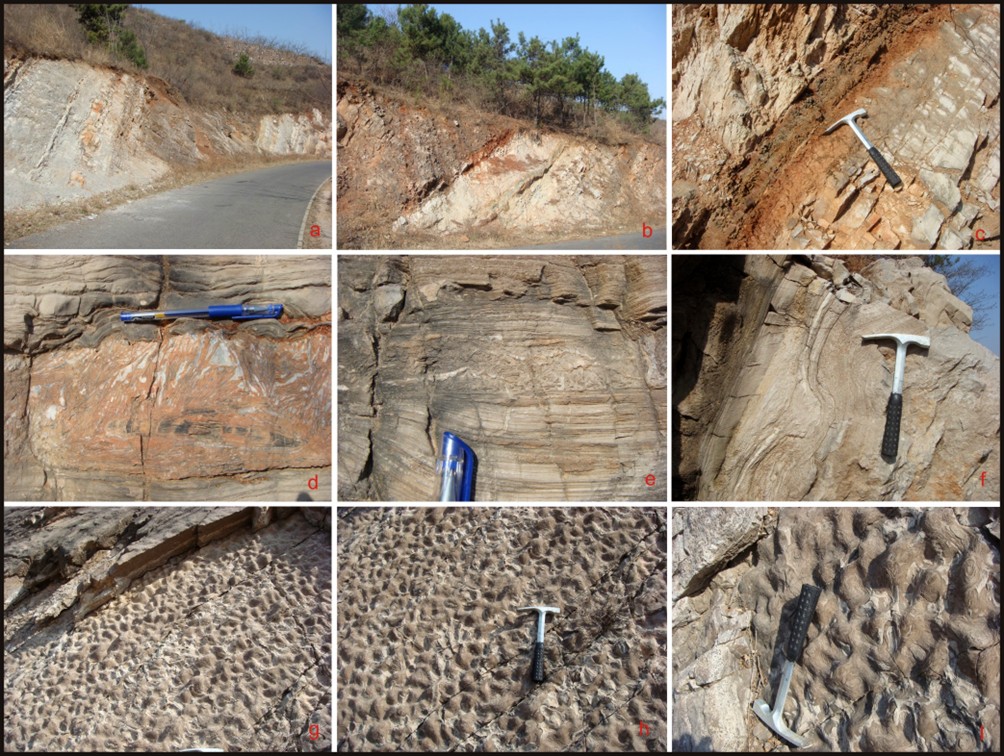Wumishan Fm
Type Locality and Naming
Jixian County, Tianjin. The Wumishan Fm was named by Gao Zhenxi (Kao, C. S.), Xiong Yongxian (Hsiung, Y. H.) and Gao Ping (Kao, P.) in 1934. The naming locality is Sujiayu Gully, 9 km northeast of Jixian County, Tianjin Municipality.
Synonym: (雾迷山组)
Lithology and Thickness
The Wumishan Fm is composed of Mg-rich mega-thick-bedded carbonate rock (dolomitic), which is characterized by distinct rhythmic layering, abundant chert, stromatolites and microplants. It is subdivided into four members. First member (842 m thick): the lower part is rhythmic layering of grey-white medium-thick-bedded, silty, muddy dolomite and chert-banded dolomite, accompanied with laminated bituminous dolomite; and the upper part consists rhythmic layering of grey, dark-grey medium-thick bedded, chert-banded coarse-crystalline dolomite, bituminous dolomite, sandwiched with grey-white thick-mega thick-bedded silty microcrystalline dolomite. Second member (755 m thick): the lower part is a rhythmic layering of grey-white thick-bedded chert-bearing fine-crystalline dolomite, bituminous laminated dolomite and stromatolite dolomite with chert bands; and the upper part is grey-white schistose muddy and silty microcrystalline dolomite, variegated thick mega-thick coarse-crystalline limy dolomite, dark-grey laminated bituminous dolomite, chert-banded dolomite and black chert rock. Third member (877 m thick): the base is purple-red thick-bedded silt-bearing microcrystalline dolomite; the lower part consists of rhythmic layering of grey, greyish silty microcrystalline dolomite, limy dolomitic conglomerate, microcrystalline limy dolomite, black chert bands and chert beds; and the upper part is dark grey thick-bedded microcrystalline limy dolomite with grey-white siliceous lamination and bands, while the top, oolitic dolomite, microcrystalline limy dolomite and purple-red medium-bedded clastic microcrystalline dolomite. Fourth member (862 m thick): the base is a grey-white, dolomitic sandstone; the lower part consists of grey-white limy coarse-crystalline dolomite, dark-grey, chert-banded dolomite, bituminous dolomite, stromatolite dolomite; the upper part is greyish chert-banded dolomite; and the top is a mega-thick-bedded stromatolite dolomite. The bedding in the formation is commonly straight and planar or is slight undulation and oblique, and ripple marks and desiccation cracks are often seen on the bedding surface. The total thickness is 3340 m.
[Figure: Wumishan Fm in Qipanmo Mt. in Jixian section. a,b,c-Dolomite interbedded with mudstone; d,e-Storm beds; f-Stromatolites g,h,i-Siliceous bedding with ripples]
Relationships and Distribution
Lower contact
Conformable onto the underlying Yangzhuang Fm. The basal surface of a mega-thick chert-striped dolomite is taken as its base boundary.
Upper contact
It has a conformable contact with overlying Hongshuizhuang Fm
Regional extent
Tianjin Municipality, Beijing Municipality and Hebei. The formation is widely distributed in Yan-Liao District, for example, in north sector of Yan-shan Mountain it is thinned in Xinglong, Pingquan, even the upper strata are absent sometimes; in west sector, it is seriously thinned, and the thickness is less than one-third in Jixian. Moreover, the sand and mud content is high and the microcrystalline dolomite is developed in the base. In the east sector, starting from northeast of Tangshan City, the formation is obviously thinned and dominated by thin- to medium-bedded microcrystalline dolomite, and stromatolite dolomite can be seen rarely. In western Liaoning, the Wumishan Fm is exposed in Lingyuan, Jianchang, Chaoyang, Harqin Zuogi,Yixan, Beizhen and Fuxin, where it is basically stable in lithological character, and is dominated by medium- to thick-bedded dolomitic limestone and chert-bearing dolomitic shale. A quartz sandstone or quartz breccia lies in the base. In Lingyuan it has stromatolites and microplants. It varies seriously in thickness, for example, it is up to 5427 m thick in Chaoyang, but 3000 m thick in Jinxi, Lingyuan, and only 2000 m in Jianping.
GeoJSON
Fossils
Stromatolites in the first member include Microstylus- Pseudogymnosolen assemblage; in second member, Conophyton lituum-Jacutophyton assemblage. The black-chert in first member of the formation contains rich microalgae fossils, such as Oscillatoriopsis jixianensis, Palaeolyngbya elliptica, Saccophycus nitidus, Templuma sinica, Pandorinopsis jixianensis. The second to fourth members have rich microplants, such as Polynucella, Glottimorpha, Leiofusa, Nucellosphaeridium.
Age
Depositional setting
Additional Information
The paleomagnetic polarity during the Wumishan Fm deposition period was negative and the paleomagnetic pole was -18.2°N, 49.2° (Zhang Huimin et al., 1991).
